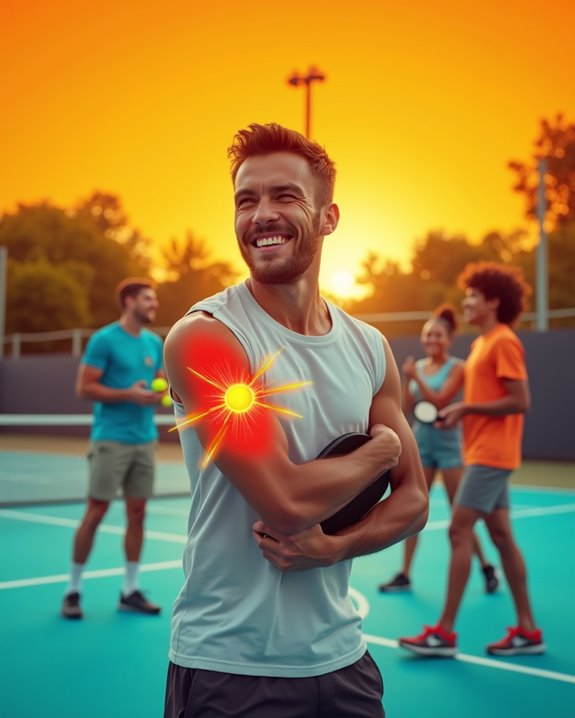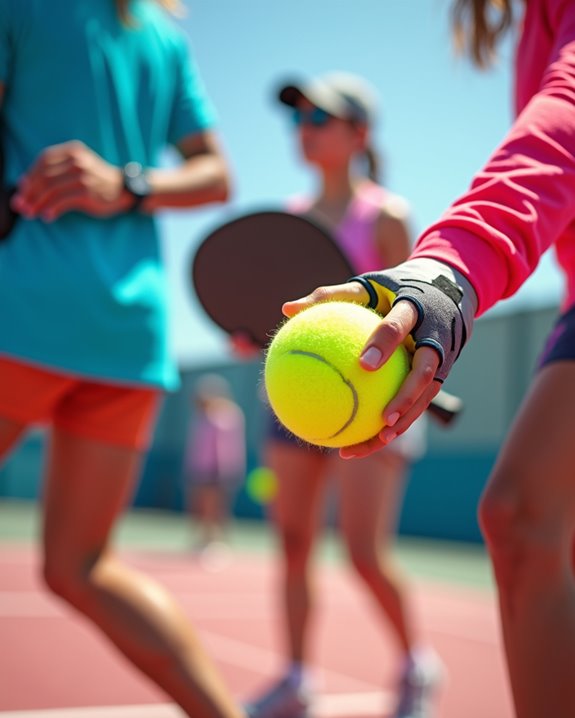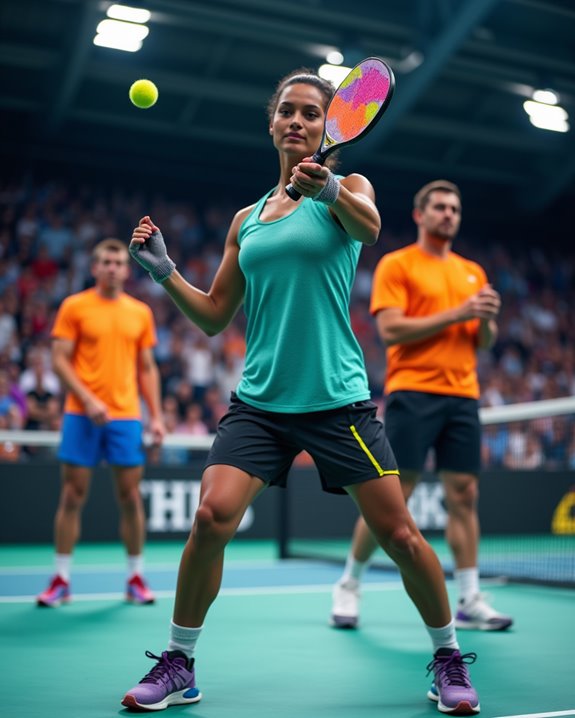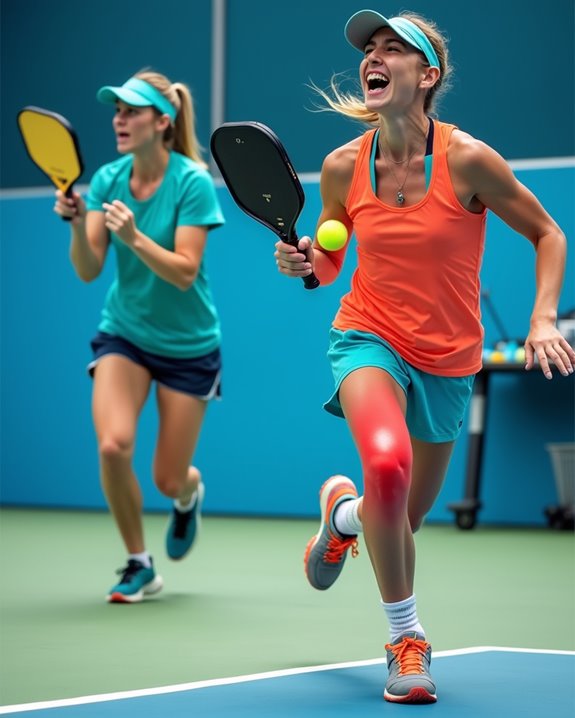Upper arm pain in pickleball often stems from rotator cuff injuries, tendonitis, or muscle strains caused by repetitive overhead motions. You’ll notice symptoms like persistent discomfort, limited range of motion, or sharp pain during your powerful serves. Treat early issues with the RICE method and proper warm-ups including arm circles and shoulder rolls. For prevention, focus on proper technique, choose paddles with shock-absorbing materials, and incorporate regular strengthening exercises. Discover how equipment adjustments can transform your comfort on the court.
Key Takeaways
- Common pickleball-related arm pain stems from rotator cuff injuries, shoulder impingement, tendonitis, and muscle strains due to repetitive motions.
- Sharp pain, persistent discomfort, limited range of motion, and reduced strength are warning signs requiring medical attention.
- Proper technique, including two-handed backhands and avoiding explosive overhead smashes, significantly reduces injury risk.
- Shock-absorbing paddles with graphite or composite materials help minimize vibration transfer to the arm.
- Effective treatment combines the RICE method, targeted rehabilitation exercises, and gradually returning to play after adequate recovery.



Understanding the Anatomy of Upper Arm Pain in Pickleball Players
When you’re dishing up powerful serves or folding in those quick volleys at the kitchen line, your upper arm is working overtime like a well-used mixing spoon. Your upper arm contains essential ingredients—the humerus bone, muscles, tendons, and ligaments—that can get overcooked with repetitive motions.
The recipe for upper arm pain often includes rotator cuff injuries, which occur when those vital shoulder tendons become inflamed or torn. Shoulder impingement happens when you’re repeatedly raising your arm overhead, causing tissues to get pinched—like vegetables crowded in a too-small sauté pan. Your biceps tendon is particularly vulnerable during those sizzling forehand drives and overhead smashes. Pay attention to symptoms like tenderness, weakness, or pain that spreads like sauce toward your shoulder or elbow.
Common Causes of Upper Arm Discomfort During Pickleball Play
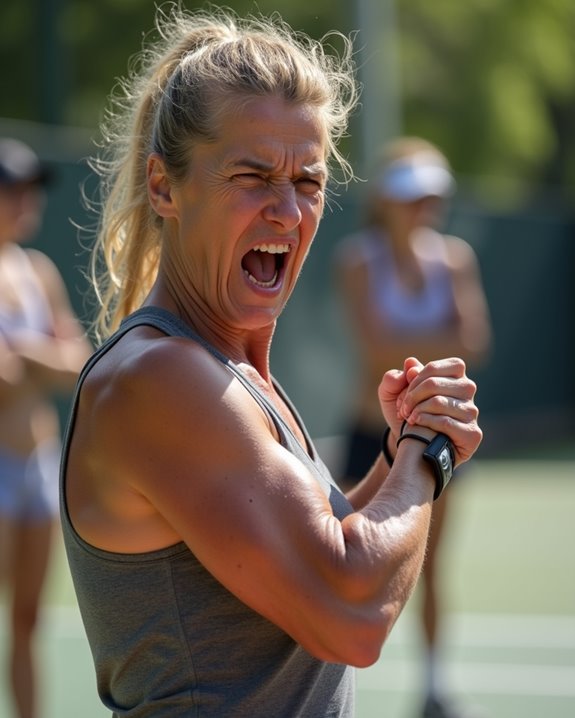
Pickleball players often experience a smorgasbord of upper arm discomfort that can sour an otherwise delicious game. Your rotator cuff is particularly vulnerable to injury—like overcooked meat, these tendons can tear from repetitive overhead motions, serving up weakness and limited mobility.
Shoulder impingement, another common ingredient in pickleball shoulder pain, occurs when tendons rub against bone during your powerful serves. It’s like herbs getting crushed too aggressively—inflammation is inevitable.
Tendons and bones colliding during your power serve—a recipe for shoulder inflammation that’s impossible to un-stir.
You might also encounter labral tears, which fold into your game like a poorly executed fold in a soufflé, creating that distinctive “catching” sensation. Biceps tendonitis adds a spicy, throbbing pain to the recipe of pickleball injuries.
Don’t forget the simple muscle strains—these raw ingredients of discomfort can be prevented with proper warm-up techniques.
Recognizing Warning Signs: When Upper Arm Pain Requires Attention
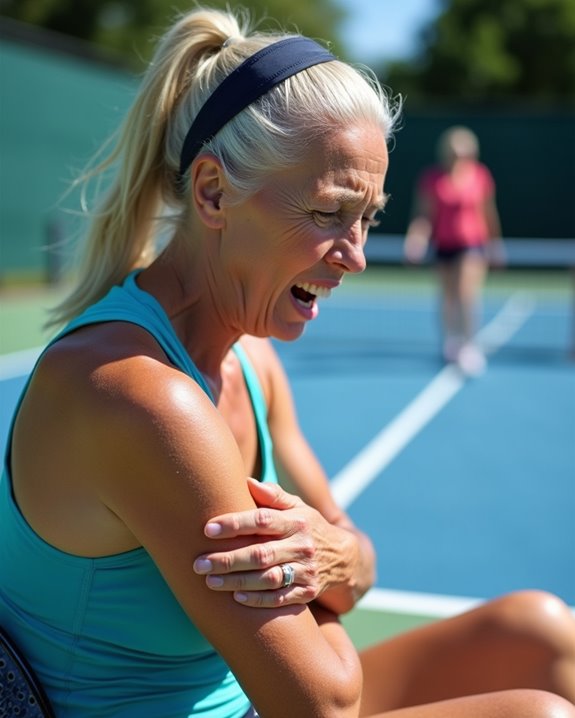
Unlike a perfectly ripened avocado that’s ready when slightly soft, your body sends clear signals when arm pain has crossed from normal muscle fatigue into concerning territory.
Persistent pain lasting more than a few days isn’t something to simmer on low heat—it requires attention. When your pickleball smashes are accompanied by sharp pain or a concerning “pop” (like breaking pasta), it’s time to seek medical attention. You shouldn’t ignore difficulty raising your arm or performing everyday activities, as these symptoms often indicate serious shoulder injuries such as rotator cuff tears.
Think of swelling, bruising, or strength reduction as your body’s smoke alarm—don’t silence it! Early intervention is the secret ingredient to effective recovery, just as timing is essential when folding egg whites into soufflé batter.






The Connection Between Pickleball Technique and Upper Arm Injuries
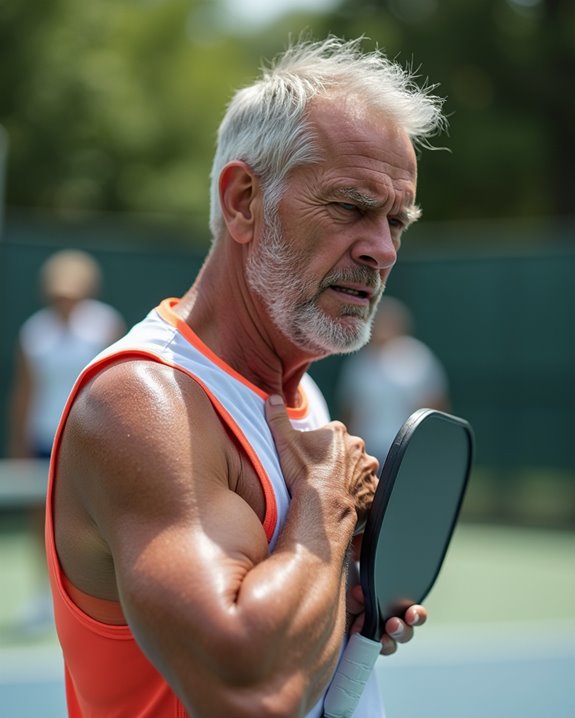
Although mastering the perfect dink shot might be your primary focus, your playing technique serves as the foundational roux for upper arm health on the pickleball court. Poor form—like a death grip on your paddle or wild, uncontrolled swings—can simmer into painful tendonitis and muscle strains.
Those explosive overhead smashes feel magnificent when executed properly, but without proper warm-up, they’re a recipe for biceps tendon inflammation. You’ll want to fold in some preventative measures: consider switching to a two-handed backhand to distribute force more evenly across your muscles.
Strength training is the secret ingredient that stabilizes your shoulder and upper arm, while regular technique check-ups with certified instructors will guarantee you’re not accidentally whisking up future injuries with every swing.
Essential Warm-Up Exercises to Protect Your Upper Arms

Before you serve up your first shot of the day, you’ll need to properly prep those upper arms like a chef tenderizing meat. A 10-15 minute warm-up and cool-down routine is your recipe for success on the pickleball court.
Start with dynamic movements—arm circles and shoulder rolls—to simmer up blood flow to your shoulder and elbow joints. Fold in some gentle overhead stretches for your biceps and triceps to maintain that muscle elasticity. For a more robust flavor, whisk in resistance band external rotations to strengthen those shoulder stabilizers.
Medical Treatments for Acute and Chronic Upper Arm Pain
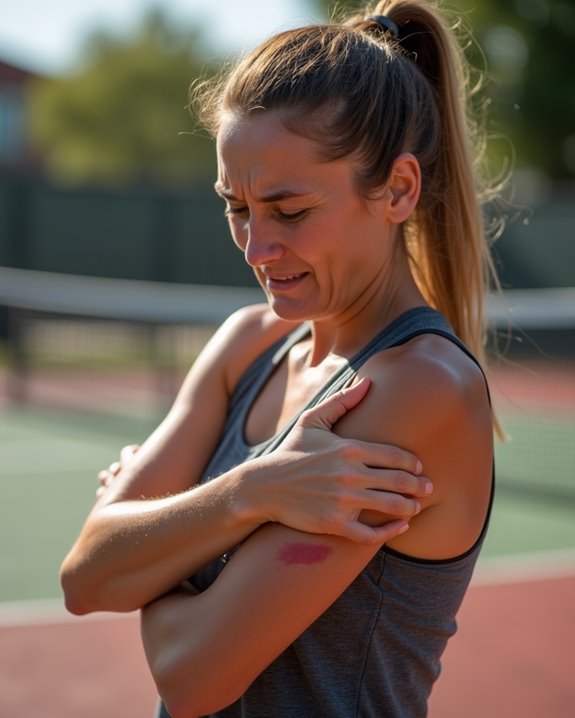
When pain strikes your upper arm after a powerful serve or an aggressive dink shot, you’ll need to know which medical treatments to dish up for relief. For fresh injuries, start with the RICE recipe: Rest, Ice, Compression, and Elevation – a perfect appetizer for recovery.
Your treatment plan might include anti-inflammatory medications like ibuprofen to simmer down the swelling. Physical therapy serves as the main course, offering exercises that will strengthen and stretch your upper arm muscles. For stubborn pain that won’t cool down, seek medical advice about corticosteroid injections – they’re like a quick reduction sauce for inflammation. In rare cases where conservative treatments fall flat, surgical options might be the final course needed to get you back to slicing those perfect shots across the kitchen line.
Rehabilitation Strategies for Returning to Pickleball After Injury
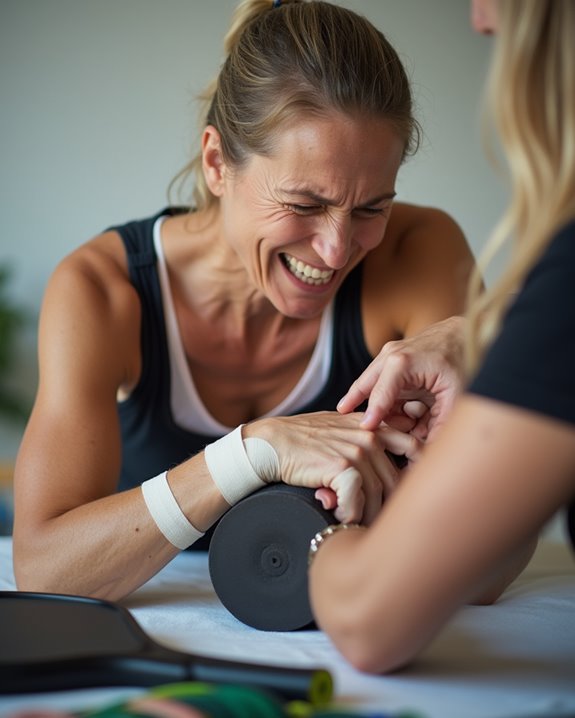
Getting back on the pickleball court after an injury requires a carefully crafted recipe, not a rushed return that’ll leave you with a bitter taste of setbacks. Your rehabilitation journey should simmer slowly, beginning with gentle practice sessions to gauge pain levels before cranking up the heat to full-intensity play.
Working with a physical therapist is like having a master chef guide your recovery. They’ll whip up a personalized plan of exercises that strengthen your shoulder and arm muscles while folding in flexibility training to restore your range of motion.
Fold injury prevention into your pre-game prep by implementing a structured warm-up routine. This essential ingredient includes dynamic stretches and light cardio that primes your body for the crisp volleys and powerful drives awaiting you on the court.
Strengthening Routines to Prevent Future Upper Arm Issues
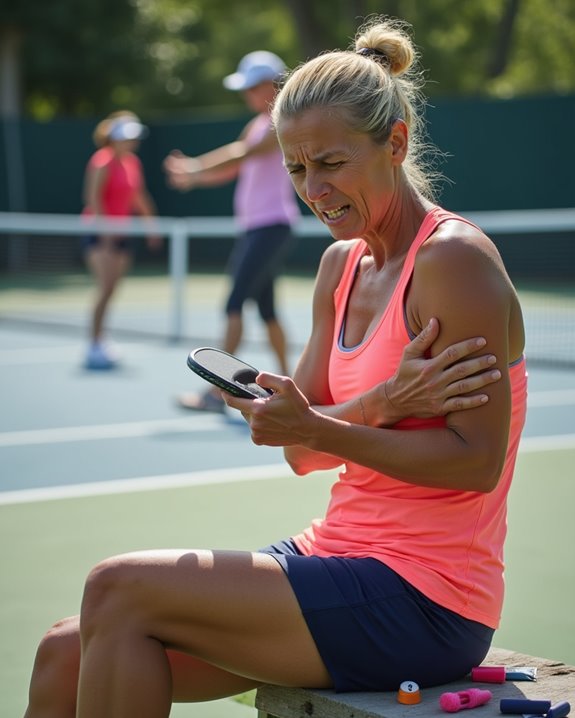
Fortifying your upper arm muscles serves as the secret sauce for preventing those painful pickleball injuries that can keep you benched for weeks. Like simmering a perfect reduction, consistent strength training creates a protective barrier against the sharp, sudden movements that can tear through unprepared tissues.
Start by folding rotator cuff strengthening exercises into your weekly routine—external rotations and scapular retractions should be your go-to ingredients. You’ll want to blend these with dynamic stretches such as arm circles that improve your range of motion. For a complete injury prevention recipe, don’t forget the core exercises—planks and bridges—which support your upper body mechanics like a sturdy cutting board supports your prep work. Gradually increase your training intensity, allowing your muscles to proof properly before returning to those sizzling rallies.
Equipment Modifications That Reduce Upper Arm Strain
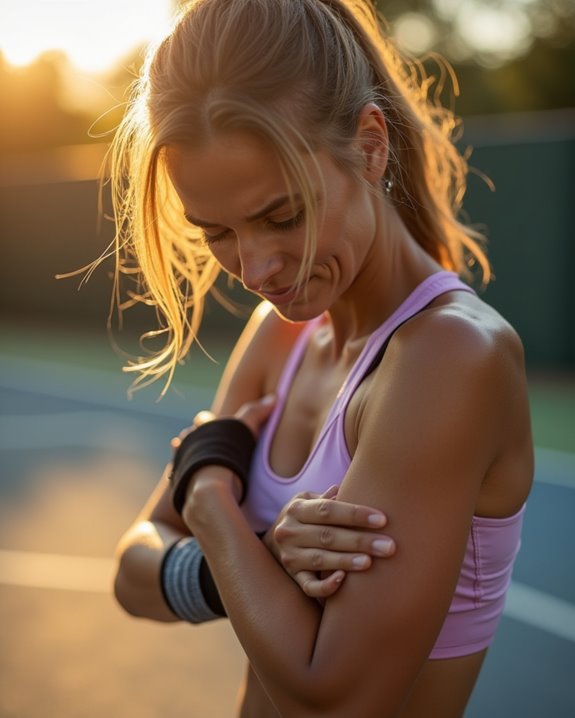
The right pickleball paddle serves as your most essential ingredient in the recipe for pain-free play. When selecting equipment modifications to reduce upper arm strain, focus on paddles that are lightweight and well-balanced—they’ll fold less tension into your muscles with each stroke.
You’ll want to whisk away potential pain by choosing paddles with larger sweet spots that transfer energy more efficiently. Don’t forget to simmer on grip size! A properly fitted handle prevents the excessive squeezing that can lead to arm discomfort.
For the perfect finishing touch, select paddles made from shock-absorbing materials like composite or graphite. These ingredients help dampen vibrations that travel up your arm. Consider paddles with lower string tension too—they’ll serve up more power while requiring less effort from your upper arm. Additionally, paddles featuring shock-absorbing cores can significantly reduce strain on the elbow during gameplay.
Long-Term Management Plan for Players With Recurring Upper Arm Pain
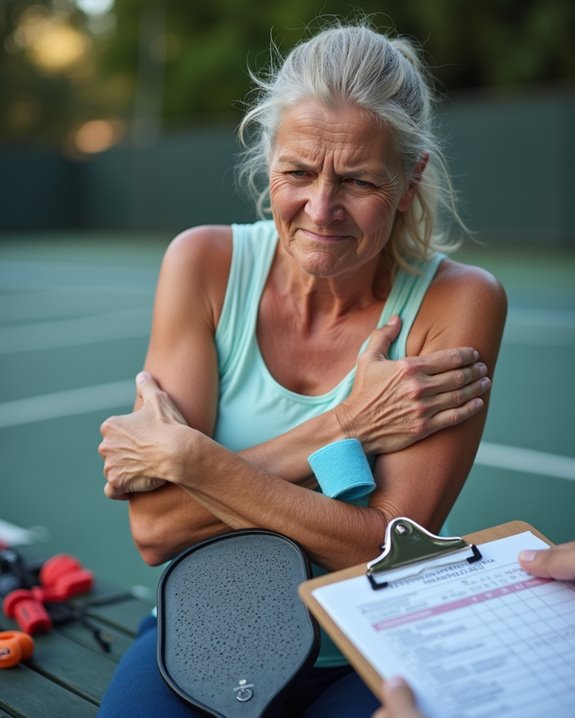
While the right equipment reduces immediate strain, persistent upper arm pain requires a well-crafted long-term management plan—just like a slow-simmered sauce that develops depth over time.
You’ll need to fold several ingredients into your recovery recipe. Start with a structured physical therapy regimen to strengthen those shoulder muscles, creating a robust foundation for your powerful serves. Don’t skip your pre-game warm-up—it’s the preheating that guarantees your muscles are ready for action.
Mix in cross-training activities that maintain your fitness without overworking that tender arm. Just as you’d rest your dough between kneading, incorporate rest days to prevent overuse injuries. Finally, schedule regular check-ins with sports medicine professionals who can fine-tune your technique, like a chef adjusting seasonings for the perfect dish.
Frequently Asked Questions
Why Does My Upper Arm Hurt After Pickleball?
Your upper arm pain likely stems from muscle fatigue and repetitive strain during gameplay. These overuse injuries happen when you’re making those frequent swings and overhead shots without proper rest or technique.
What Is the Best Treatment for Upper Arm Pain?
For your upper arm pain, you’ll benefit from RICE method for immediate pain relief methods. Follow with rehabilitation exercises in physical therapy, and adopt preventative measures like proper warm-ups before returning to activities.
How Do You Treat Pickleball Shoulder Pain?
For pickleball shoulder pain, you’ll need rest, ice, and anti-inflammatories for pain relief. Follow with rehabilitation exercises from physical therapy. Don’t forget preventive measures like proper warm-ups and technique adjustments to avoid reinjury.
What Causes Upper Arm Pain Without Injury?
You can develop upper arm pain without injury through muscle strain from poor posture, nerve compression from daily activities, and repetitive motion stress. Your body’s compensating patterns often create discomfort without traumatic events.

